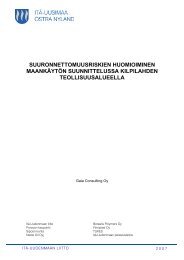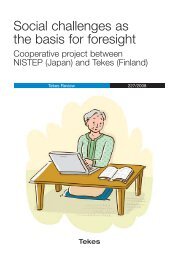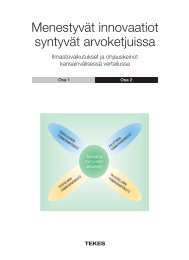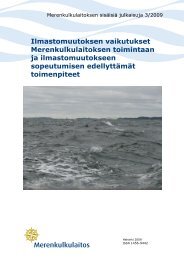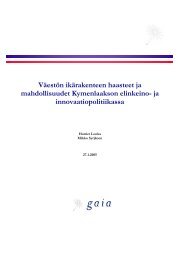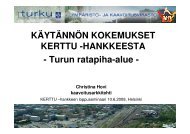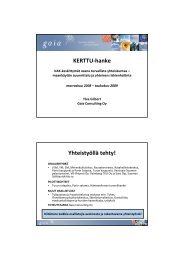Climate Risk Management in Finnish Development Cooperation - Gaia
Climate Risk Management in Finnish Development Cooperation - Gaia
Climate Risk Management in Finnish Development Cooperation - Gaia
You also want an ePaper? Increase the reach of your titles
YUMPU automatically turns print PDFs into web optimized ePapers that Google loves.
Ethiopia. As noted above, the climate screen<strong>in</strong>g has been complemented by a prelim<strong>in</strong>ary<br />
assessment of potential direct and/or <strong>in</strong>direct implications of climate change <strong>in</strong> Ethiopia for<br />
F<strong>in</strong>land. 9<br />
This pilot assessment has looked at F<strong>in</strong>nish development cooperation and climate<br />
adaptation needs <strong>in</strong> Ethiopia on three complementary levels, i.e. country level, sector level<br />
and programme/project level. The prelim<strong>in</strong>ary climate screen<strong>in</strong>g 10 focused on the water<br />
sector portfolio, which forms a cornerstone of F<strong>in</strong>nish development cooperation with<br />
Ethiopia. With<strong>in</strong> the water sector, three programmes/projects have been reviewed,<br />
provid<strong>in</strong>g examples of a variety of projects <strong>in</strong> different phases of their project cycle.<br />
Given the overall objectives of the study as well as the pilot nature of this screen<strong>in</strong>g exercise,<br />
the “comb<strong>in</strong>ed approach” used <strong>in</strong> this study has drawn on experiences and lessons learned<br />
from a series of climate screen<strong>in</strong>g forerunner countries and organizations (<strong>in</strong> particular<br />
ORCHID - Opportunities and <strong>Risk</strong>s of <strong>Climate</strong> Change and Disasters, DANIDA climate change<br />
screen<strong>in</strong>g matrixes and CRiSTAL/Community-based <strong>Risk</strong> Screen<strong>in</strong>g – Adaptation and<br />
Livelihoods, see Annex III). It also makes use of the climate risk management methods and<br />
experiences (such as the <strong>Climate</strong>-CIVA 11 method) elaborated as part of the F<strong>in</strong>nish national<br />
climate research adaptation programme 12 . This “comb<strong>in</strong>ed approach” has allowed<br />
consideration of climate risks widely from a strategic po<strong>in</strong>t of view as well as from a<br />
livelihoods po<strong>in</strong>t of view.<br />
The “comb<strong>in</strong>ed approach” used <strong>in</strong> this study is presented <strong>in</strong> figure 1 below. The objective<br />
has been to <strong>in</strong>tegrate risks of climate change and opportunities for adaptation <strong>in</strong>to the<br />
development programme rather than as stand-alone climate adaptation (or mitigation)<br />
projects. This could be achieved <strong>in</strong> a manner that acknowledges latest climate science,<br />
communicates climate risks <strong>in</strong> an easily understandable manner to all relevant stakeholders,<br />
allows <strong>in</strong>tegrat<strong>in</strong>g climate risk management and reduces any climate vulnerability <strong>in</strong> a<br />
manner that does not overstretch programme/project staff resources and supports reach<strong>in</strong>g<br />
of specific project objectives and development objectives at large.<br />
9 See Annex I. These potential implications may be reflected e.g. through environment and conflict l<strong>in</strong>kages,<br />
<strong>in</strong>creased need for humanitarian assistance and disaster risk reduction, <strong>in</strong>creased migration and immigration,<br />
potential repercussions through trade etc. This project component will serve more broadly the ISTO research<br />
programme and make use of prelim<strong>in</strong>ary scop<strong>in</strong>g activities conducted with<strong>in</strong> it. See ISTO project IMPLIFIN: an<br />
<strong>in</strong>vestigation of the <strong>in</strong>ternational impacts of climate change hav<strong>in</strong>g potential implications for F<strong>in</strong>land, conducted<br />
by the F<strong>in</strong>nish Environment Institute (SYKE), F<strong>in</strong>land.<br />
10 The climate change screen<strong>in</strong>g will <strong>in</strong>clude an assessment of the risks of climate change <strong>in</strong> achiev<strong>in</strong>g the<br />
outcomes of the F<strong>in</strong>nish development programmes and identification of opportunities for reduced vulnerability.<br />
It will provide a prelim<strong>in</strong>ary screen<strong>in</strong>g of selected on-go<strong>in</strong>g activities and guidance for apply<strong>in</strong>g a “climate lens”<br />
on planned and forthcom<strong>in</strong>g activities.<br />
11 The <strong>Climate</strong>-CIVA method (<strong>Climate</strong> Induced Vulnerability Assessment, <strong>in</strong> F<strong>in</strong>nish Ilmasto-KIHA), developed<br />
with<strong>in</strong> the F<strong>in</strong>nish adaptation research programme (ISTO), is a decision-mak<strong>in</strong>g tool that allows systematic risk<br />
mapp<strong>in</strong>g, impact assessment and identification of priority adaptation solutions.<br />
12 The approach can also provide a screen<strong>in</strong>g for disaster risks reduction especially <strong>in</strong> some parts of Ethiopia<br />
where disasters are predom<strong>in</strong>antly associated with droughts and floods.<br />
7



